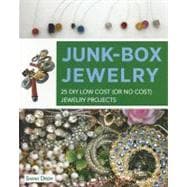
| Getting Started | p. 10 |
| What You'll Need | p. 12 |
| Where to Look | p. 16 |
| Vintage Glamour | p. 20 |
| Retro-Bauble Bracelet | p. 22 |
| Vintage Braided Choker | p. 24 |
| Bling Ring | p. 27 |
| Royal Jewels Necklace | p. 30 |
| Vintage Lace Choker | p. 33 |
| Beach Finds | p. 36 |
| Sea-Jewel Pendant | p. 38 |
| Colorful Recycled Necklace | p. 41 |
| Ocean's Charm Bracelet | p. 44 |
| Fishing-Net Cuff | p. 45 |
| Sea-Jewel Cuff | p. 50 |
| Sixties String-Art Necklace | p. 54 |
| Use What You Have | p. 56 |
| Elegant First-Date Earrings | p. 58 |
| Art Nouveau Pendant | p. 60 |
| Jeweled Branches Necklace | p. 63 |
| Newsstand Necklace | p. 66 |
| Toolbox Bracelet | p. 68 |
| Customized Cuff | p. 70 |
| Juliet Tiara | p. 72 |
| So-Quirky-lt's-Cool Necklace | p. 75 |
| Diva Designs | p. 78 |
| Billie Holiday Headband | p. 80 |
| Sparkle-and-Chain Necklace | p. 83 |
| Art Deco Bracelet | p. 86 |
| Sparkling Vines Headband | p. 89 |
| Antique Lace Headband | p. 92 |
| Golden Touch Tiara | p. 95 |
| Useful Websites | p. 100 |
| Index | p. 102 |
| Table of Contents provided by Ingram. All Rights Reserved. |
The New copy of this book will include any supplemental materials advertised. Please check the title of the book to determine if it should include any access cards, study guides, lab manuals, CDs, etc.
The Used, Rental and eBook copies of this book are not guaranteed to include any supplemental materials. Typically, only the book itself is included. This is true even if the title states it includes any access cards, study guides, lab manuals, CDs, etc.